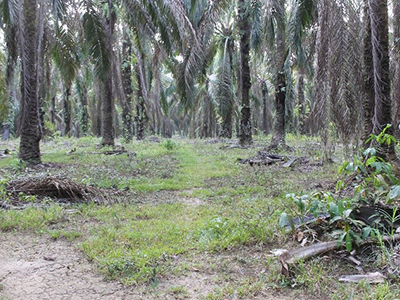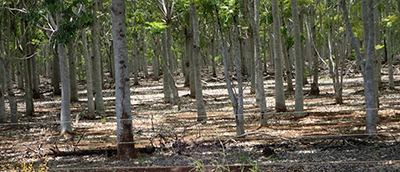Forage available under mature plantations
There is a theory that there is enough light under mature oil palms to grow 1,000kg per hectare of dry matter (DM) of forage grass each year.
This 1,000kg is the amount grown if all of the areas under the palm plantation is forage. In reality, taking into account the palm stem areas, the weeded circles around the palm trunks, the harvest paths and the frond piles, only about 66 per cent of the area is available for growing forage. This means that only
660kg of forage DM can be grown per hectare per year. Of this 660kg, cattle can sustainably consume (utilise) about half, or 330kg. Some of the forage will be lost through trampling by grazing animals or will naturally senesce and die. With tropical grasses, the amount of pasture cattle can eat (intake) becomes limiting when the amount of available forage falls below 300kg per hectare.
If the size of the grazing animals is known (450kg), an annual carrying capacity can be calculated using the expected forage production (660kg/ha/year), utilisation rate (50 per cent) and animal intake (8kg DM/head/day). For this situation, the annual carrying capacity is thus approximately one animal to nine hectares.
The practice for oil palms in Indonesia
During trips to Indonesia for the PalmCow Project, the Department of Industry, Tourism and Trade’s Principal Pastures Agronomist Arthur Cameron inspected a number of mature oil palm plantations in three provinces: East Kalimantan, South Sumatra and West Sumatra. These plantations were 25 years or older.
Arthur observed that under mature stands of productive oil palms there was little or no edible forage available for grazing livestock. Arthur also saw only one plantation with 27 year old oil palms of a less productive variety, where he estimated forage yield to be approximately 1,000kg per hectare of dry matter. This forage yield was similar to that for a 16 year old plantation of a productive palm variety nearby.


Vegetation under 25 year old productive oil palms (left) and 27 year old productive oil palms (right). Yield is low, with little edible forage available.
Similarly, Arthur observed the same low forage availability under well grown African mahogany plantations in the Douglas Daly District.

Vegetation under African mahogany.
The implication of these observations is that there will be limited or no forage resources available for cattle under mature productive plantations.
Contact
Arthur Cameron
P: 08 8999 2214
